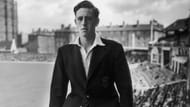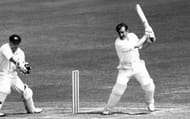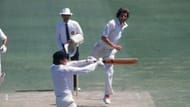
In the past, apart from seasoned cricketers, quite often the tour promoters, the umpires, the coaches, the baggage-men, and even the pressmen had to fill in for the touring MCC side in Australia when there were sudden injuries to squad members.
Some of them got a chance to play in the tour matches and others, much to their surprise, were lucky enough to play Test matches as well.
As Tom Curran, who replaced Steven Finn for Ashes 2017-18, makes an entry into this list, let's take a look at the English cricketers who were not part of the initial squad to Australia but went on to play Test matches on those tours.
Reg Wood (1886-87)
Cheshire-born Wood was a left-arm medium pacer who featured occasionally in the 1880s but didn't progress because there was suspicion about the legitimacy of his bowling action. He emigrated to Australia and was called up to play for England when Billy Barnes broke his hand. Wood played three times for the tourists, one of them being the Test match at the MCG. He made 6 and 0 and that was the last time he appeared in a First-class match.
George Gunn (1907-08)
Gunn batted well during Nottinghamshire's successful county championship campaign of 1907. But ill-health plagued him and, heeding the advice of his friends, he went to warmer Australia conditions during the English winter. He was drafted into the side when A.O. Jones fell ill with pneumonia.
Gunn made his debut in the first Test and scored 119 and 74. He batted well in all five Test and finished with a series average in excess of 50.

Brian Statham (1950-51)
Freddie Brown was named the captain for England's tour of Australia in 1950-51 as both Norman Yardley and George Mann were unavailable. It was a bizarre squad that was selected to head Down Under. Six of the seven specialist batsmen were openers and half a dozen were under the age of 25 as well.
In January, two extras flew out, Roy Tattersall and Brian Statham. When Trevor Bailey fractured a thumb, a replacement was required. Fellow Lancastrian Cyril Washbrook recommended Statham who then had to fly from chilly Lancashire to the sweltering heat in Adelaide.
Bailey missed the Adelaide Test but Statham was not asked to play. He played a few FC matches before making his debut in New Zealand. He impressed one and all with his never-ending stamina and discipline, going on to become one of England's best fast bowlers.
Roy Tattersall (1950-51)
Tattersall was flown out to Australia when Doug Wright pulled a groin muscle. The injury though wasn't that serious and both Wright and Tattersall played in the last two Test matches. Tattersall picked up four wickets in Adelaide but couldn't stop Australia from taking a 4-0 lead in the series.
Then, in the final match of the series in Melbourne, Tattersall played a role in England's famous win. He didn't pick any wickets but scored some very vital runs, batting at number eleven in the first innings. Reg Simpson was batting on 92 when Tattersall joined him in the middle. He somehow survived the over so that his partner could hit a four, two and three to complete a remarkable century. They went on to add 74 for the last wicket with Tattersall scoring 10 of them.

Ted Dexter (1958-59)
Dexter was summoned when Raman Subba Row (groin), Arthur Milton (hand) and Willie Watson (knee) all succumbed to injury. It was a forgettable trip for the English cricketers as very few things went well for them. Dexter batted four times in the two Tests he played in Australia, managing a meagre 18 runs. He then went to New Zealand though and scored his maiden century there. He went on to have a long and successful career with England, even serving as the captain of the cricket team and later, the chairman of selectors.
John Mortimore (1958-59)
Mortimore was an off-break bowler who served Gloucestershire for 25 years. A few matches into the 1958-59 tour, the England team management realised that they needed additional spin resources to support Tony Lock who had a bad knee. At the recommendation of Laker, they called up Mortimore to join the team as an additional spinning option. He only managed to play in one of the Test matches but batted well, scoring 55 runs and being dismissed only once. However, he didn't make his mark with the ball.
Despite that, he played eight more Test matches for England.

Barry Knight (1965-66)
Knight was a useful all-rounder who found himself out of favor with the England side for over 18 months prior to this Ashes series. He was flown out to Australia on an emergency basis when David Larter (heel) and David Brown (side muscles) were ruled out for a few weeks. Knight played in two of the Test matches, taking six wickets in the first one. He didn't have a great time with the bat, though. He found himself in and out of the England side and played his last Test match against the Kiwis in 1969.
Bob Willis (1970-71)
Ray Illingworth, before sailing off for Australia, was very optimistic about his fast bowling pair of Alan Ward and John Snow. Ward though only managed to play a couple of tour games before being ruled out with a broken ankle. Ken Shuttleworth took his place in the first couple of Test matches and bowled decently. Then, Bob Willis, flown out of England as a replacement, made his debut in the fourth Test of the series and immediately made an impact. While Snow was the pick of the bowlers, he was ably supported by Willis who went on to have a successful career as an opening bowler for England.
Follow IPL Auction 2025 Live Updates, News & Biddings at Sportskeeda. Get the fastest updates on Mega-Auction and cricket news
